|
|
|
Sort Order |
|
|
|
Items / Page
|
|
|
|
|
|
|
| Srl | Item |
| 1 |
ID:
105447


|
|
|
|
|
| Publication |
2011.
|
| Summary/Abstract |
Western geopolitical discourse misrepresents and constructs Central Asia as an inherently and essentially dangerous place. This pervasive 'discourse of danger' obscures knowledge of the region, deforms scholarship and, because it has policy implications, actually endangers Central Asia. This article identifies how the region is made knowable to a US-UK audience through three mutually reinforcing dimensions of endangerment: Central Asia as obscure, oriental, and fractious. This is evidenced in the writings of conflict resolution and security analysts, the practices of governments, the activities of international aid agencies and numerous lurid films, documentaries and novels. The article first establishes the tradition of inscribing danger to Central Asia, in both academic and policy discourse, from the colonial experience of the nineteenth century through to the post-Soviet transition and subsequent considerations of the region in terms of the war on terror. It considers several examples of this discourse of danger including the popular US TV drama about presidential politics, The West Wing, the policy texts of 'Washingtonian security analysis' and accounts of danger, insecurity and urban violence in the Ferghana Valley. It is argued that popular policy and academic texts are relatively consistent across the three dimensions of endangerment. This argument is demonstrated through a discussion of how policy-making and practice is informed by this discourse of danger and of how the discourse of danger is contested within the region. The example of urban violence in Osh, Kyrgyzstan and Jalalabad, Afghanistan in 2010 demonstrates how opportunities to mitigate conflict may have been lost due to the distortions of this discourse of danger. It concludes by raising the challenge to policy-makers, journalists and academics to contest this western geopolitical discourse and provide better accounts of how danger is experienced by Central Asians.
|
|
|
|
|
|
|
|
|
|
|
|
|
|
|
|
| 2 |
ID:
077527
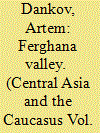

|
|
|
| 3 |
ID:
127593
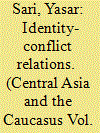

|
|
|
|
|
| Publication |
2013.
|
| Summary/Abstract |
This study aims to describe and explain the relations between identity and conflict by drawing on different theoretical approaches in political science. It examines the questions of whether collective identity, either on a national, civilizational, religious, or social level, is an important variable in trying to understand current conflicts, as well as the prospects for formulating identity-based approaches to conflict. In other words, is it even possible to think about collective identity and conflict simultaneously? This gives rise to another question: Why is collective identity an important factor for explaining the conflict in the Ferghana Valley?
The Ferghana Valley has played a role both in establishing stability in Central Asia and in becoming the starting point of violent conflict throughout the history of the region. The valley became administrationally and ethnically divided into several parts during the Soviet and post-Soviet era. Currently, the tension among the different ethnic, social, and political groups is high because of overpopulation, the increasing scarcity of water and arable land, and the economic hardships and social differentiation that occurred during the political, economic, and social transformation after the Soviet Union collapsed. The Ferghana Valley, at the heart of Central Asia, has become one of the most conflict-prone areas in Central Asia. For these reasons, the valley is a good area for testing the explanatory power of different approaches of political science to explain identity-conflict relations.
Ethnic issues are still extremely important for understanding much of the tension arising in the valley. Not only is there division among the Kyrgyz, Uzbek, and Tajik people, the issue is further complicated by the hostility between different identity-groups and minorities in the region. Additional pressure is arising due to the fact that not only does this tension exist inside each state, it could also escalate to the interstate level.
|
|
|
|
|
|
|
|
|
|
|
|
|
|
|
|
| 4 |
ID:
127594
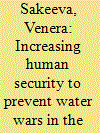

|
|
|
|
|
| Publication |
2013.
|
| Summary/Abstract |
The Ferghana Valley is shared by three Central Asian republics of Kyrgyzstan, Uzbekistan, and Tajikistan. Largely agrarian, the communities residing in the area are heavily dependent on the availability of water for irrigation. As a result of Soviet-backed imaginary border removal and the creation of new borders, the communities became highly vulnerable to state policies and are challenged in establishing relations with each other. The deteriorated environmental conditions, such as dry climate and drought, have only fueled the competition among households to ensure their access to the scarce water resources. Without timely and comprehensive intervention strategies, the region can be compared to a time bomb that could have irreversible consequences.
This article will examine the water problem in the Ferghana Valley from the perspective of a human security approach. In particular, it will analyze the trilateral spurious relations among environmental, economic, and community insecurities derived from the scarcity of water resources and lack of comprehensive water management strategies. To elaborate, it will look into how environmental insecurity has multidimensional impacts on economic and community security in the Ferghana Valley. This research with go on to identify the existing approaches to addressing the aforementioned issues and will scrutinize them to see whether or not they address human security of the communities residing in the Ferghana Valley. Subsequently, the article will propose an alternative solution that meets the principles of human security-friendly policies and will discuss strategies to improve alternative intervention within the framework of "do no harm."
|
|
|
|
|
|
|
|
|
|
|
|
|
|
|
|
| 5 |
ID:
072230
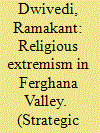

|
|
|
| 6 |
ID:
152007
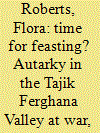

|
|
|
|
|
| Summary/Abstract |
The well-established narrative of the Soviet Union’s victory in the Great Patriotic War emphasizes the enormous sacrifices that it entailed, and the extraordinary sufferings of both the Red Army and the entire civilian population. Throughout the war years, however, reports of lavish feasting and conspicuous consumption taking place on collective farms in northern Tajikistan continued to be submitted to Moscow. The ‘culprits’ were usually local Soviet officials, who appear to have reverted to traditional redistributive practices and modes of patronage. I argue that such acts of ‘anti-Soviet sabotage’ do not necessarily prove that Central Asians understood themselves as colonized subjects making the most of a temporary reprieve from state intrusion. The war in fact casts into sharp relief the extent to which many local officials of the Tajik SSR perceived themselves as loyal Soviet citizens – and as good Muslims, too.
|
|
|
|
|
|
|
|
|
|
|
|
|
|
|
|
|
|
|
|
|